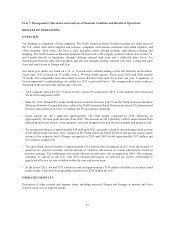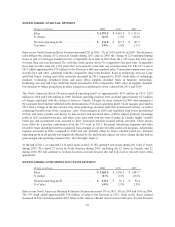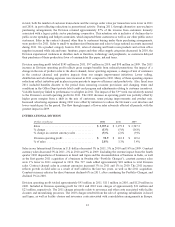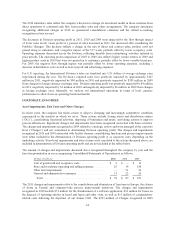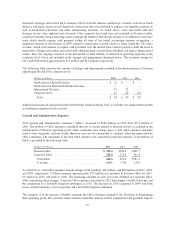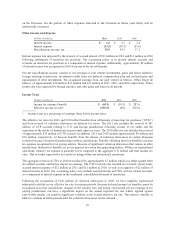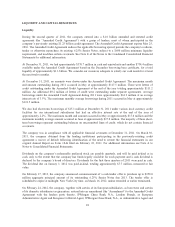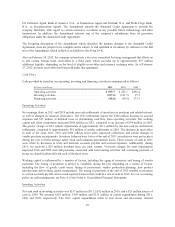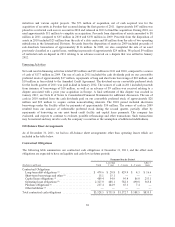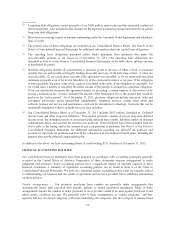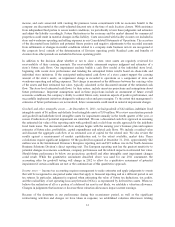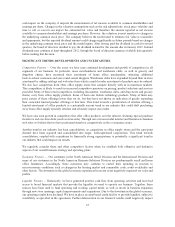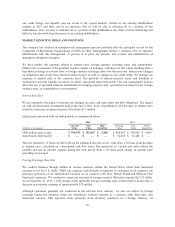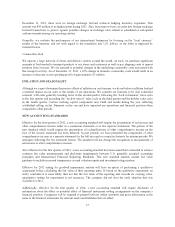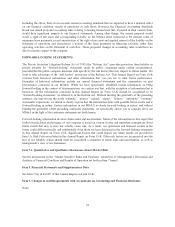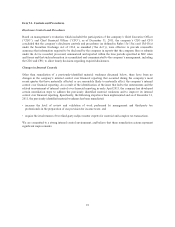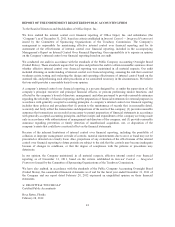Office Depot 2011 Annual Report Download - page 33
Download and view the complete annual report
Please find page 33 of the 2011 Office Depot annual report below. You can navigate through the pages in the report by either clicking on the pages listed below, or by using the keyword search tool below to find specific information within the annual report.
(1) Long-term debt obligations consist primarily of our $400 million senior notes and the associated contractual
interest payments. Also included in this amount are the expected payments (principal and interest) on certain
long-term debt obligations.
(2) Short-term borrowings consist of amounts outstanding under the Amended Credit Agreement and subsidiary
lines of credit.
(3) The present value of these obligations are included on our Consolidated Balance Sheets. See Note E of the
Notes to Consolidated Financial Statements for additional information about our capital lease obligations.
(4) The operating lease obligations presented reflect future minimum lease payments due under the
non-cancelable portions of our leases as of December 31, 2011. Our operating lease obligations are
described in Note G of the Notes to Consolidated Financial Statements. In the table above, sublease income
is distributed by period.
(5) Purchase obligations include all commitments to purchase goods or services of either a fixed or minimum
quantity that are enforceable and legally binding on us that meet any of the following criteria: (1) they are
non-cancelable, (2) we would incur a penalty if the agreement was cancelled, or (3) we must make specified
minimum payments even if we do not take delivery of the contracted products or services. If the obligation
is non-cancelable, the entire value of the contract is included in the table. If the obligation is cancelable, but
we would incur a penalty if cancelled, the dollar amount of the penalty is included as a purchase obligation.
If we can unilaterally terminate the agreement simply by providing a certain number of days notice or by
paying a termination fee, we have included the amount of the termination fee or the amount that would be
paid over the “notice period.” As of December 31, 2011, purchase obligations include television, radio and
newspaper advertising, sports sponsorship commitments, telephone services, certain fixed assets and
software licenses and service and maintenance contracts for information technology. Contracts that can be
unilaterally terminated without a penalty have not been included.
(6) Our Consolidated Balance Sheet as of December 31, 2011 includes $452 million classified as “Deferred
income taxes and other long-term liabilities.” This caption primarily consists of our net long-term deferred
income taxes, the unfunded portion of our pension plan, deferred lease credits, liabilities under our deferred
compensation plans, and accruals for uncertain tax positions. These liabilities have been excluded from the
above table as the timing and/or the amount of any cash payment is uncertain. See Note F of the Notes to
Consolidated Financial Statements for additional information regarding our deferred tax positions and
accruals for uncertain tax positions and Note H for a discussion of our employee benefit plans, including the
pension plan and the deferred compensation plan.
In addition to the above, we have outstanding letters of credit totaling $111.4 million at December 31, 2011.
CRITICAL ACCOUNTING POLICIES
Our consolidated financial statements have been prepared in accordance with accounting principles generally
accepted in the United States of America. Preparation of these statements requires management to make
judgments and estimates. Some accounting policies have a significant impact on amounts reported in these
financial statements. A summary of significant accounting policies can be found in Note A of the Notes to
Consolidated Financial Statements. We have also identified certain accounting policies that we consider critical
to understanding our business and our results of operations and we have provided below additional information
on those policies.
Vendor arrangements — Our inventory purchases from vendors are generally under arrangements that
automatically renew until cancelled with periodic updates or annual negotiated agreements. Many of these
arrangements require the vendors to make payments to us or provide credits to be used against purchases if and
when certain conditions are met. We generally refer to these arrangements as “vendor programs,” and they
typically fall into two broad categories, with some underlying sub-categories. The first category is volume-based
31


